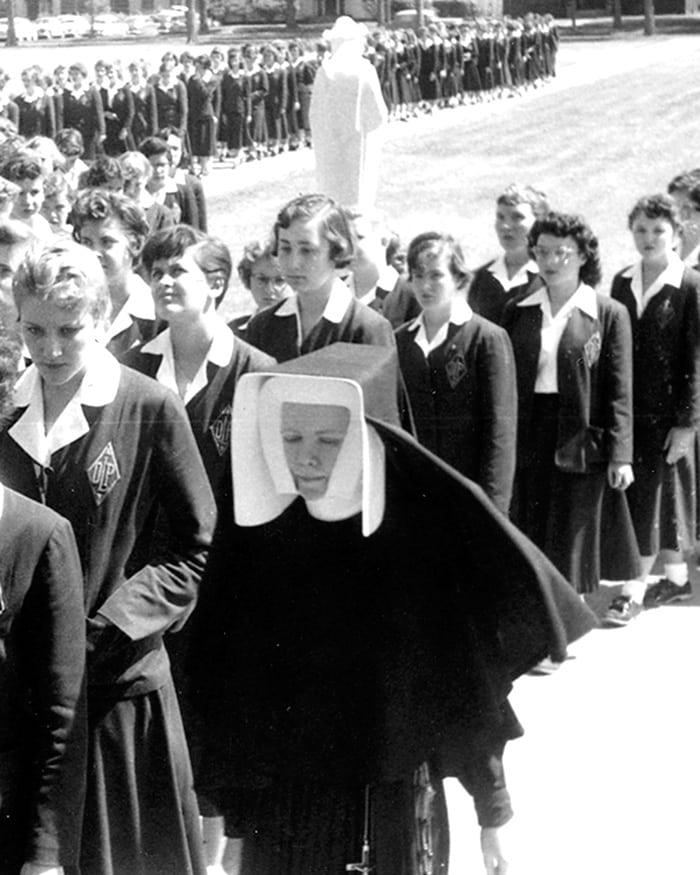
Our Lady of Peace High School 1952-56
By Patricia Cummings
In 1952 I became an O.L.P. girl by default. On the day I was to get measured for my Derham Hall uniform, Mother and Dad told me that I couldn’t go there after all and they immediately took me, in tears, down to Our Lady of Peace High School to register. It was a financial decision. Grudgingly, I joined the 190 girls who made up the second graduating class at O.L.P., which quickly had been dubbed the “Old Ladies Prison” by the boys at Cretin.
In 1951, a group of Sisters of Charity of the Blessed Virgin Mary (BVMs) had come from Dubuque to open their first school in Saint Paul. The Sisters assigned to create the new school were the crème de la crème of the BVM order. Sister Mary Adorinus was the first principal.
The BVMs wore impossibly constricting head gear—a rigid, ruched box around each face, covered by a second starched box that extended past the profile and topped off with a black veil. They couldn’t drive cars because they had no peripheral vision. Their habits were full-length black wool serge with voluminous cape-like tops and very large rosaries that fastened around their waists. One time, as Sister Mary Annelle was trying to get off a city streetcar, her rosary got caught in the doors and she was dragged for a block before she was rescued. Her heavy habit saved her from serious injury.
We students wore navy blue suits with white blouses. The jackets had breast pockets with the school emblem in blue and gold. The skirts were gored and had to measure fourteen inches from the floor, no matter how tall you were, so when we stood in a line all the hems were at the same level. Our shoes were orthopedic—navy blue tie shoes with crepe soles that had to be whitened for special occasions. We wore nylons every day. Some girls tried drawing “seams” up the backs of their legs with eyebrow pencil, so they could avoid wearing those nylons, but the nuns were wise to that trick.
Modesty in dress was one of the values of the Church during the 1950s and, consequently, of O.L.P. Strapless dresses, halters, and spaghetti straps were forbidden. The “rule” that you couldn’t wear patent leather shoes because they reflected your underwear seemed to fall into the category of a Catholic “urban legend,” but it kept being repeated. Chastity, the ultimate virtue, manifested itself in some strange ways. We couldn’t dance to “Night Train” because it was too sensual. We had to be careful when we slow-danced, lest we get too close. We couldn’t go steady because it would lead us into temptation.
As good Catholic girls, we looked forward to most of O.L.P.’s religious observances. But not to the annual silent retreat. Jesuits took us through an arduous three-day process designed by St. Ignatius Loyola. Everyone dreaded the last session on the second day—the “fire and brimstone” session. The priest described, in excruciating detail, the horrors of hell that awaited us if we didn’t follow the Catholic rules. Each year, we girls succumbed to this scare tactic and dissolved in tears, sometimes bordering on hysteria. As I recall, redemption happened on the third day when we all went to confession.
While adhering to Church dogma, the BVMs often took the “less traveled road” in more practical matters. When it was time to build an addition to the original school building, philanthropist I.A. O’Shaughnessy offered a substantial donation, but required that the new building be named for him. The Sisters politely refused because they never named BVM buildings after donors. The addition got built without I.A.’s money and was named Philomena Hall. Because the Sisters couldn’t justify the cost, O.L.P. didn’t have the traditional hardcover yearbook. Instead, we had a paperback Memory Book. And we didn’t have a traditional valedictorian because the nuns thought a successful education was more than just a high GPA. Instead, a Scholarship Medal was awarded.
After four unexpectedly happy years, I graduated in June of 1956. We wore white caps and gowns and processed into the Saint Paul Auditorium Theater to the “Triumphal March” from Aida. No “Pomp and Circumstance” for us. We left behind the blue uniforms and marched forward to college, or jobs, or marriage, or, even for some, the BVM novitiate in Dubuque.